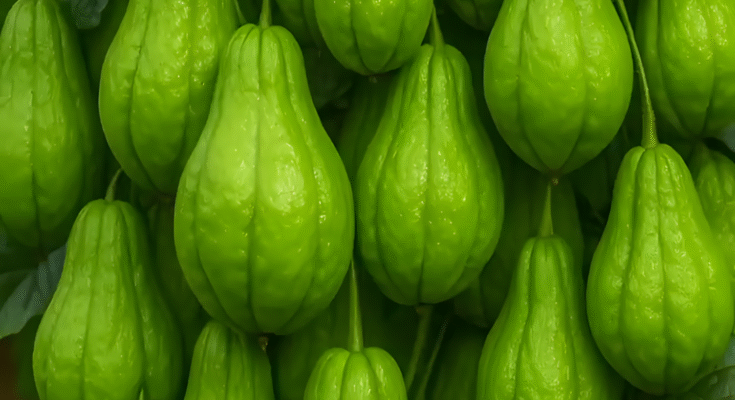Easy Method to Grow and Propagate Chayote Trees
Chayote (Sechium edule) is a climbing vine plant from the gourd family, commonly grown for its edible fruit, shoots, and leaves. Known in many regions as “vegetable pear” or “mirliton,” chayote is popular in tropical and subtropical countries because of its fast growth, productivity, and simple cultivation methods. The plant thrives well in warm climates with adequate rainfall and sunlight, making it an excellent choice for home gardens and small farms. Learning an easy method to grow and propagate chayote trees can help you enjoy a steady supply of nutritious vegetables right from your backyard.
Understanding the Chayote Plant
Chayote is not actually a “tree” but a vigorous perennial vine that can grow up to 12 meters long if properly supported. It produces green, pear-shaped fruits that are smooth or slightly wrinkled, depending on the variety. Unlike many other fruiting plants, chayote propagation is unique because each fruit already contains a single large seed inside. When the fruit matures, this seed can sprout while still inside the fruit, making the propagation process very easy and natural.
The plant prefers well-drained soil rich in organic matter, and it flourishes in warm, humid conditions. Once established, a single chayote vine can produce fruits for several years with proper care, making it both economical and sustainable.
Propagation of Chayote – The Easy Way
The easiest and most reliable method to propagate chayote is by using whole fruits rather than extracting the seed. Unlike other crops where seeds are removed and sown separately, chayote’s seed is soft and fragile, and removing it may damage its ability to germinate. Instead, you simply plant the entire fruit in soil and allow it to sprout naturally.
Step 1: Select Healthy Fruits
Choose mature, medium-to-large-sized chayote fruits. Make sure they are free from disease, cracks, or insect damage. Mature fruits are usually firm and light green in color. The best fruits for planting are those that already show signs of sprouting at the stem end, as this indicates readiness for growth.
Step 2: Prepare the Planting Site
Chayote requires plenty of space and a support system such as a trellis, arbor, or fence. Since it is a climbing vine, planting it near a sturdy support ensures that the plant can grow vertically, keeping fruits clean and reducing pest problems. Select a sunny location with at least six hours of direct sunlight daily.
Prepare the soil by loosening it 30–40 cm deep. Mix in compost or well-rotted manure to enrich the soil with organic nutrients. Chayote grows best in slightly acidic to neutral soil (pH 6.0–7.0).
Step 3: Plant the Fruit
Dig a hole about 15–20 cm deep. Place the whole chayote fruit on its side, with the sprouting end slightly angled upward. Cover the fruit lightly with soil, leaving the sprout tip exposed if it has already started to grow. If the fruit has not sprouted yet, bury it completely but shallow enough for the sprout to push out easily.
Space each plant about 3–4 meters apart to allow ample room for vine growth.
Step 4: Watering and Mulching
Water the planting hole thoroughly after planting. Chayote prefers consistent moisture but not waterlogged soil. Regular watering, especially during dry periods, helps establish strong roots. Applying a layer of mulch around the base will help retain moisture, suppress weeds, and improve soil fertility.
Caring for Chayote Vines
Once the chayote vine starts growing, it requires minimal but consistent care to ensure healthy development and fruit production.
- Trellising: Provide a strong trellis, bamboo framework, or wire netting for the vines to climb. A sturdy support system prevents fruits from touching the ground, reducing rot and pest attacks.
- Fertilization: Apply organic compost or balanced fertilizer every 4–6 weeks during the growing season. This boosts flower and fruit production.
- Pruning: Trim excessive shoots to encourage better air circulation and direct the plant’s energy toward fruiting rather than uncontrolled growth.
- Pest and Disease Control: Common pests include aphids, whiteflies, and fruit flies. Regularly inspect leaves and fruits, and use organic sprays like neem oil or garlic extract if infestations appear. Ensure good spacing to reduce fungal diseases.
Harvesting Chayote
Chayote fruits are usually ready for harvest 120–150 days after planting. Harvest young and tender fruits for the best flavor. Mature fruits can be stored and also used for replanting in the next season. A well-maintained vine can produce dozens of fruits in a season, providing a continuous harvest.
Additional Uses of Chayote
Beyond its delicious fruits, chayote offers other benefits:
- Young shoots and leaves are edible and can be cooked like spinach.
- Roots of the plant are starchy and sometimes eaten in certain cuisines.
- Nutritional value: Chayote is rich in vitamin C, folate, potassium, and dietary fiber, making it a healthy addition to meals.
Conclusion
Growing and propagating chayote is one of the easiest gardening projects for both beginners and experienced growers. By planting a whole fruit instead of removing its delicate seed, you can quickly establish a healthy vine that produces abundant food for years. With just a little preparation, proper support, and consistent care, your chayote vines will reward you with nutritious fruits, edible shoots, and even roots that can be enjoyed in various dishes. Whether you have a large farm or a small backyard, chayote is a practical, productive, and easy-to-grow plant that deserves a spot in your garden.



